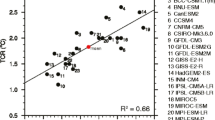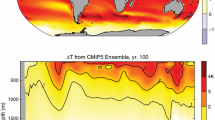Abstract
Finite computer resources force compromises in the design of transient numerical experiments with coupled atmosphere-ocean general circulation models which, in the case of global warming simulations, normally preclude a full integration from the undisturbed pre-industrial state. The start of the integration at a later time from a climate state which, in contrast to the true climate, is initially in equilibrium then induces a cold start error. Using linear response theory a general expression for the cold start error is derived. The theory is applied to the Hamburg CO2 scenario simulations. An attempt to estimate the global-mean-temperature response function of the coupled model from the response of the model to a CO2 doubling was unsuccessful because of the non-linearity of the system. However, an alternative derivation, based on the transient simulation itself, yielded a cold start error which explained the initial retardation of the Hamburg global warming curve relative to the IPCC results obtained with a simple box-diffusion-upwelling model. In the case of the sea level the behaviour of the model is apparently more linear. The cold start error estimations based on a CO2 doubling experiment and on an experiment with gradually increasing CO2 (scenario A) are very similar and explain about two thirds of the coupled model retardation relative to the IPCC results.
Similar content being viewed by others
References
Cubasch U, Santer BD, Maier-Reimer E, Böttinger M (1990) Sensitivity of a global ocean atmosphere circulation model to a doubling of carbon dioxid. In: Pitcher EJ (ed) Science and engineering on supercomputers. Springer, Berlin Heidelberg Tokyo, pp 347–352
Cubasch U, Hasselmann K, Hock H, Maier-Reimer E, Mikolajewicz U, Santer BD, Sausen R (1992) Time-dependent greenhouse warming computations with a coupled ocean-atmosphere model. Clim Dyn 8:55–69
Houghton JT, Jenkins GJ, Ephraums JJ (1990) Climate change. The IPCC scientific assessment. Cambridge University Press, Cambridge, UK
Maier-Remier E, Hasselmann K (1987) Transport and storage of CO2 in the ocean — an inorganic ocean-circulation carbon cycle model. Clim Dyn 2:63–90
Manabe S, Bryan K, Spelman MJ (1990) Transient response of a global ocean-atmosphere model to doubling of atmospheric carbon dioxide. J Phys Oceanogr 20:722–749
Stouffer RJ, Manabe S, Bryan K (1989) Interhemispheric asymmetry in climate response to a gradual increase of atmospheric CO2. Nature 342:660–662
Washington WM, Meehl GA (1989) Climate sensitivity due to increased CO2: experiments with a coupled atmosphere and ocean general circulation model. Clim Dyn 4:1–38
Wigley TMC (1991) A simple inverse carbon cycle model. Global Biogeochem Cyc 15:373–382
Author information
Authors and Affiliations
Rights and permissions
About this article
Cite this article
Hasselmann, K., Sausen, R., Maier-Reimer, E. et al. On the cold start problem in transient simulations with coupled atmosphere-ocean models. Climate Dynamics 9, 53–61 (1993). https://doi.org/10.1007/BF00210008
Received:
Accepted:
Issue Date:
DOI: https://doi.org/10.1007/BF00210008




